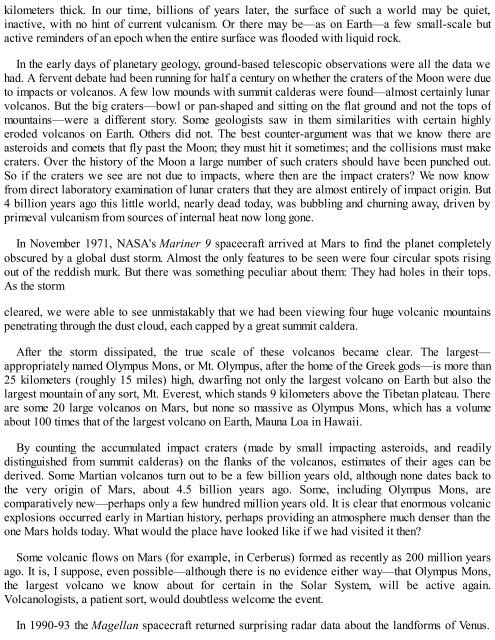Pale Blue Dot ( PDFDrive.com ) (1)
Create successful ePaper yourself
Turn your PDF publications into a flip-book with our unique Google optimized e-Paper software.
kilometers thick. In our time, billions of years later, the surface of such a world may be quiet,<br />
inactive, with no hint of current vulcanism. Or there may be—as on Earth—a few small-scale but<br />
active reminders of an epoch when the entire surface was flooded with liquid rock.<br />
In the early days of planetary geology, ground-based telescopic observations were all the data we<br />
had. A fervent debate had been running for half a century on whether the craters of the Moon were due<br />
to impacts or volcanos. A few low mounds with summit calderas were found—almost certainly lunar<br />
volcanos. But the big craters—bowl or pan-shaped and sitting on the flat ground and not the tops of<br />
mountains—were a different story. Some geologists saw in them similarities with certain highly<br />
eroded volcanos on Earth. Others did not. The best counter-argument was that we know there are<br />
asteroids and <strong>com</strong>ets that fly past the Moon; they must hit it sometimes; and the collisions must make<br />
craters. Over the history of the Moon a large number of such craters should have been punched out.<br />
So if the craters we see are not due to impacts, where then are the impact craters? We now know<br />
from direct laboratory examination of lunar craters that they are almost entirely of impact origin. But<br />
4 billion years ago this little world, nearly dead today, was bubbling and churning away, driven by<br />
primeval vulcanism from sources of internal heat now long gone.<br />
In November 1971, NASA's Mariner 9 spacecraft arrived at Mars to find the planet <strong>com</strong>pletely<br />
obscured by a global dust storm. Almost the only features to be seen were four circular spots rising<br />
out of the reddish murk. But there was something peculiar about them: They had holes in their tops.<br />
As the storm<br />
cleared, we were able to see unmistakably that we had been viewing four huge volcanic mountains<br />
penetrating through the dust cloud, each capped by a great summit caldera.<br />
After the storm dissipated, the true scale of these volcanos became clear. The largest—<br />
appropriately named Olympus Mons, or Mt. Olympus, after the home of the Greek gods—is more than<br />
25 kilometers (roughly 15 miles) high, dwarfing not only the largest volcano on Earth but also the<br />
largest mountain of any sort, Mt. Everest, which stands 9 kilometers above the Tibetan plateau. There<br />
are some 20 large volcanos on Mars, but none so massive as Olympus Mons, which has a volume<br />
about 100 times that of the largest volcano on Earth, Mauna Loa in Hawaii.<br />
By counting the accumulated impact craters (made by small impacting asteroids, and readily<br />
distinguished from summit calderas) on the flanks of the volcanos, estimates of their ages can be<br />
derived. Some Martian volcanos turn out to be a few billion years old, although none dates back to<br />
the very origin of Mars, about 4.5 billion years ago. Some, including Olympus Mons, are<br />
<strong>com</strong>paratively new—perhaps only a few hundred million years old. It is clear that enormous volcanic<br />
explosions occurred early in Martian history, perhaps providing an atmosphere much denser than the<br />
one Mars holds today. What would the place have looked like if we had visited it then?<br />
Some volcanic flows on Mars (for example, in Cerberus) formed as recently as 200 million years<br />
ago. It is, I suppose, even possible—although there is no evidence either way—that Olympus Mons,<br />
the largest volcano we know about for certain in the Solar System, will be active again.<br />
Volcanologists, a patient sort, would doubtless wel<strong>com</strong>e the event.<br />
In 1990-93 the Magellan spacecraft returned surprising radar data about the landforms of Venus.


